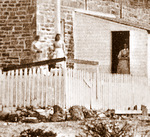 |
|||
|
|||
A Description of |
|||
A Visit to the Point Loma Lighthouse |
|||
When Eliza Bridges Jones McKellar and John Jenkins were keepers |
|||
from The San Diego Union, January 16, 1869 |
|||
|
By the kind invitation of Mr. Morse, we made one of a party of four, last Sunday, and visited the airy lighthouse on Point Loma. The day was one of the many indescribably lovely days with which San Diego seems to be blessed. The feeling of freedom and relaxation with which we took a seat in the carriage, seemed to meet with a generous response from the bracing atmosphere, and “all the cares and concerns of this transitory life" flitted away, long before the horses had dashed into the turbid waters of the San Diego. A little further on, — where the green hilltop slopes gently down to the waters of the Bay, innumerable stakes denote the streets and blocks of an embryo city. The horses cantered gaily over the greensward along the water’s verge, and our friend took particular pains to inform us that we were passing through the principal street of Rose city; where the lady passengers amused themselves by building airy castles upon innumerable blocks and filling the streets with industrious denizens. A few minutes more and we were among the ruins of the Playa. At the end of a little wooden walk, not far from the shore, stands a small cabin-on-stilts in which is kept the time gauge. Back some distance from the Bay stands an old dilapidated building, once occupied by the government as the Customs House; but the only building in which a live soul could be seen was the residence of Mrs. Brown. The place is five miles from Old Town, and, in years “lang syne" was the place of landing for vessels entering this port to trade for hides. Was then, and by the old residence still, is called the “Hide Houses." Here we turned around the old Custom House and began the ascent of the mountain. The road, though bad, is not at all difficult. A very little labor would make it a good one. We passed beside some yawning pits and chasms made by the winter torrents in their mad career to the Bay, — on either hand [of] the mountain side the wild sage and southern wood were putting out their leaves and the tender blades of grass, and graceful vines and ferns in every shade of green peeped from the fruitful earth. From the summit of the hill, the scene was grand. Old San Bernadino’s frosty head rising far to the north among the Sierras, looked sublimely down from his snowy kingdom upon the silvery tinged foothills as they sloped and changed to green upon the waters of the Pacific. In the West the Quiamac, high and bluff threw back the sun’s rays from its rough bronzed sides and seemed to smile in pride upon the heads of little hills around it. As the eye wandered further South along a horizon of ether blue broken by rolling hills and pointed peaks, it rested on the grand old Table Mountain lifting its broad flat top among the clouds, but bending down toward the sea as if it sought to find its comely peak among its waves. And on, still South, the hills and valleys of the coast grew lower and the white caps of the breakers grew fainter until land and ocean seemed to blend, and the eye lost the line where ceased the ocean and began the sky. Due south arose the Coronadas—three little Islands—looking like little wanderers from home, playing truant among the billows, reckless of the frown of Mother Loma. Away to the West rolled the broad Pacific, “deeply, darkly, beautifully blue." As we paused upon the dividing ridge to gaze upon a scene so majestic so far beyond “the poet’s pen, the painters’ art," our friend directed our attention to the Northwest, where rose the Santa Catalina and San Clemente Islands, some 80 miles away. And yet, so pure and rare the atmosphere, they seemed quite near, and looked like two leviathans rising from out the vasty deep. Beneath us, near where the breakers dashed against the shore, some rust iron boilers and places in ruins marked the site where once the Mormon prophets delved to find the bed of coal supposed to underlie the mountain and the bay. The white sails of the pursuing whale boats flashed far out upon the ocean, but nearer in among the kelp, the smaller boats lay watching for the whale. A short drive up the ridge brought us to the Light House, upon the “towering topmost height." A fence, inclosing about an acre and a half, surrounds it. Mr. Jenkins, the keeper, met us at the gate, and escorted the ladies to the entrance where they were received by his wife. Neatness and order prevailed in the little enclosure. The flower beds surrounded by abalone shells, the tidy walks and neatly arranged beds of cultivated earth, told at a single glance, the tale of the taste and industry of these inhabitants of the lonely tower. Beside the walls of the house, some tomatoes were just ripening, while well grown potato vines and other garden vegetables luxuriated in the genial sun and wooing breeze. The house is strongly built of sandstone, and the iron tower rises many feet above the cone; stone steps lead to the entrance door, and then by circling narrow steps the light is gained. Of the many things we saw in and around the tower we will speak hereafter; the limited space in our paper warning us to stop here. |
 |
|
|
|||
|
©Roberta Tuller 2023
|
|||
